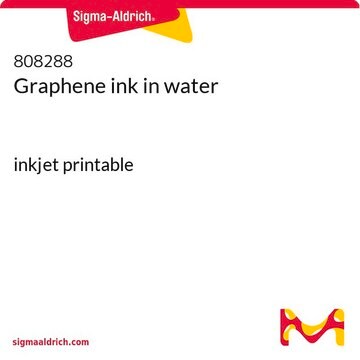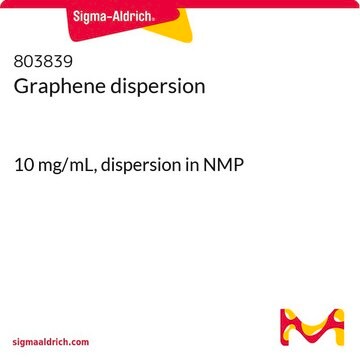As per the supplier, for spin-coating on glass, a standard iterative solvent cleaning protocol is recommended, involving 5 minutes of sonic cleaning in acetone, ethanol, and isopropanol, followed by blow-drying with N2 between each step, and then ozone plasma treatment (medium power for 2-5 minutes) to promote adhesion. The ink is also compatible with spin-coating on Si/SiO2 substrates, which can undergo the same pre-treatment protocol. When using the spin coater, spinning a single layer at 2000-5000 rpm results in a final film thickness of 40-60 nm. To achieve thicker films, multiple layers can be applied without a baking step, which is recommended over using a lower spin speed to maintain film uniformity. With 5 coats at 2000 rpm, a 200 nm thick film is obtained after baking at 300 °C for 30 minutes in air.
900960
Graphene dispersion
for spin/spray-coating, photonic annealing
Synonyme(s) :
Conductive ink, Graphene ink
About This Item
Produits recommandés
Nom du produit
Graphene ink for spin/spray coating photonically annealable, for spin-coating, spray-coating, photonic annealing
Niveau de qualité
Forme
dispersion (black)
Caractéristiques du produit alternatif plus écologique
Design for Energy Efficiency
Learn more about the Principles of Green Chemistry.
sustainability
Greener Alternative Product
Concentration
1.8-3.0 wt. % solids
Résistivité
0.003-0.005 Ω-cm, sample prepared by spin-coating at 2000 rpm/30 s for 5 coats, followed by thermal annealing at 300 °C in air for 30 minutes
Taille des particules
≤3 μm
Viscosité
2-8 mPa.s(25 °C) (1000 s-1)
pb
78 °C (ethanol)
Densité
0.78-0.88 g/mL at 25 °C
Autre catégorie plus écologique
, Enabling
Catégories apparentées
Description générale
Application
Spin-coating a single layer at 2000-5000 rpm yields a final film thickness of 40-60 nm. To achieve thicker films, multiple layers can be applied without a baking step. This is recommended over using a lower spin speed to maintain film uniformity. This ink should work on almost any substrate.
Electrical performance:
Following a baking step at 300 °C for 30 minutes in air, the spin-coated films exhibit sheet resistance of 300-800 Ω/sq, corresponding to a resistivity of 0.003-0.004 Ω−cm. With 5 coats at 2000 rpm, a 200 nm thick film with a sheet resistance of 160 Ω/sq. is obtained.
General guidelines:
Ethanol is recommended for cleaning up the ink and dried films, as well as dilution. Bath sonication (5-10 minutes) of the ink prior to use is recommended following extended periods of disuse.
Mention d'avertissement
Danger
Mentions de danger
Conseils de prudence
Classification des risques
Eye Dam. 1 - Flam. Liq. 2 - Skin Irrit. 2
Code de la classe de stockage
3 - Flammable liquids
Classe de danger pour l'eau (WGK)
WGK 1
Point d'éclair (°F)
54.5 °F - closed cup
Point d'éclair (°C)
12.5 °C - closed cup
Faites votre choix parmi les versions les plus récentes :
Déjà en possession de ce produit ?
Retrouvez la documentation relative aux produits que vous avez récemment achetés dans la Bibliothèque de documents.
Les clients ont également consulté
-
Is there a documented recipe available for spin coating 900960, including details on the substrates it works well with (specifically regular glass slides), any pre-processing required to promote adhesion, the quantities needed, and the spin rpm-thickness characteristics?
1 answer-
Helpful?
-
Active Filters
Notre équipe de scientifiques dispose d'une expérience dans tous les secteurs de la recherche, notamment en sciences de la vie, science des matériaux, synthèse chimique, chromatographie, analyse et dans de nombreux autres domaines..
Contacter notre Service technique











